The coffee industry is a multi-billion-dollar worth sector. With more than 1 billion people or 40% of the world’s population drinking coffee every day, the industry is growing massively year after year.
Some love instant and specialty coffees, while others are fans of traditional black ones. Luckily, the choice is big these days and everyone can find their perfect flavors and dose of caffeine.
Have you ever wondered how big is the coffee industry? How much is it worth? Or were you always interested in some fascinating statistics and facts regarding this everyone’s favorite beverage?
In today’s article, we’ll cover everything you need to know about coffee – from the industry and financial perspectives to the consumers, coffee shops, health and environmental impacts, and more.
Keep on reading because, in this article, you’ll find some really interesting coffee data.
Here are the topics we’ll cover today:
- General Coffee Statistics
- Coffee Industry Statistics
- Coffee Industry Employment Statistics
- Coffee Consumption Statistics
- Coffee Drinkers Demographics Statistics
- Coffee Shop Statistics
- Starbucks Coffee Statistics
- American Coffee Consumption Statistics
- Coffee Health Statistics
- Coffee Waste Statistics
16 Key Coffee Statistics (Editor’s Pick)
- People drink over 400 million cups of coffee every day.
- 35% of people drink black coffee.
- Arabica makes up more than 70% of the global coffee production.
- Brazil produces 43.2 million bags of coffee.
- 19,849 people are employed in the US coffee production industry.
- In Finland, people consume 8 or 9 cups of coffee per day.
- The global coffee shop industry is worth more than $156.9 billion.
- Europe is the largest market of coffee drinkers in the world.
- Brazil has 33% of the coffee market share.
- People aged 60 or older are the biggest coffee drinkers.
- Starbucks has 32,660 stores in the world.
- Americans drink 146 billion cups of coffee per year.
- 79% of Americans prepare coffee at home.
- American woman spends around $2,327 on coffee per year.
- Coffee drinkers have up to 80% lower risk of cirrhosis.
- 6 million tonnes of coffee waste is sent to landfills.
General Coffee Statistics
1. Billions of people drink coffee every day.
According to the data provided by Deals On Health, over 1 billion people all over the world drink coffee on a daily basis. If we only look at the coffee consumers in the United States, people there drink 400 million cups of coffee every day. Coffee is truly considered to be a nectar of life.
Source: Deals On Health
2. About 40% of the world’s population drinks coffee every day.
Speaking of billion people who simply love coffee, the statistics provided by Coffee Rank stated that about 30-40% of the entire world’s population consumes coffee every single day. That is a quite high percentage of people who enjoy this bitter beverage – almost half of the entire world!


Source: Coffee Rank
3. Coffee is a second runner in the popularity of beverages.
If we’re talking about liquid needs, water is the most frequently consumed beverage. The Perfect Brew stated that 66% of people consume water regularly, while the second runner is coffee with 63% of people who consume it on a regular basis. The data by Perfect Brew showed that drinking coffee in the morning reduces tiredness and increases alertness. That’s the reason why coffee is one of the most popular beverages in the world.
Source: Perfect Brew
4. In some countries, up to 10 kilograms of coffee is consumed per person.
Let’s get a bit specific when we’re talking about coffee consumption. According to the data by Coffee Rank, there are 3 leading countries that are described as “ruthless coffee drinkers”. Finland, Netherlands, and Sweden are the leading countries when it comes to drinking coffee in huge quantities every day. The data stated that in these countries and on yearly basis, every person consumes 9 to 10 kilograms of coffee.
Source: Coffee Rank
5. More than 30% of people drink black coffee.
Disturb-Me-Not data showed that about 35% of coffee consumers usually drink black coffee. Black coffee is often referred to as black gold and it presents a simple coffee brewed without the addition of additives such as milk, cream, sugar, or added flavors. Black coffee comes with a bit of bitter taste, however, people do love a strong cup of coffee.
Source: Disturb-Me-Not and HealthifyMe
6. Coffee Arabica is the leading brand in global coffee production.
When we’re talking about the global coffee brands that are leading the market of the coffee industry, Coffea Arabica definitely leads the way. According to Deals On Health and their data, Coffee Arabica makes up more than 70% of the global coffee production. This type of coffee is also known as Arabian coffee.
Source: Deals On Health
7. The world has 3 billion coffee plants.
The demand for coffee is constantly increasing and the need to fulfill the needs of the cafes, coffee shops, restaurants, and others is as high as it could be. According to Alann Bros Coffee, there are 3 billion coffee plants all over the world. They are used to source worldwide supplies.


Source: Alann Bros. Coffee
8. Brazil produces 2,6 million metric tons of coffee.
The NCA data states that coffee is grown in more than 50 countries all around the world. Brazil is in the first place. The country produces 2,6 million metric tons of coffee or – 43.2 million bags of coffee. Vietnam is a second runner with 1,5 million metric tons of coffee, while Colombia, Indonesia, and Honduras follow. The less well-known coffee produces countries are the United States (Hawaii to be more specific), Mexico, and Puerto Rico.
Source: NCA and Farrer’s
9. Cold-brewed coffee has less caffeine.
The data by Visual stated that cold-brewed coffee has 67% less caffeine than traditional coffee. If we look closely at this type of coffee, we can definitely say that it is healthier than the traditional one. The data shows that cold-brewed coffee is also 67% less acidic than when it is brewed hot. Due to that, it has much sweeter nuances and can have many different flavors.
Source: Visual
10. Europeans love black coffee and cappuccinos.
Regular black coffee and cappuccino are the favorite beverages amongst Europeans. Statistics show that European countries, especially northern ones, are true coffee addicts that drink record amounts of coffee per capita.
Source: Coffee Rank
11. In Italy, more than 90% of people drink espresso.
Espresso is a favorite drink in Italy. The data states that at least once a day all Italians consume coffee. And more than 90% of them drink espresso. According to Coffee Rank, espresso lovers in Italy drink 6.69 kilograms of coffee. It is often stated that Italians have coffee in their DNA. And that’s the best way to describe their love for coffee.
Source: Coffee Rank
12. About 12 kilograms of coffee is consumed per person in Finland.
Finland ranks among the world’s top coffee-consuming nations per capita, according to the data provided by Statista. There, an average of 12 kilograms of coffee is consumed per person on a yearly basis. Eight or nine cups of coffee per day is the norm in this Nordic country.


Source: Statista and Culture Trip
13. Monaco has the most locations of Starbucks per capita.
According to Food Truck Empire, Starbucks is the largest coffee chain in the world. And Monaco is the country with the most Starbucks locations per capita. However, the country’s population needs to be taken into account when talking about these statistics. The country has a little less than 40,000 inhabitants and 2 Starbucks locations.
Source: Food Truck Empire
14. You can, but you won’t overdose on caffeine.
The Healthline stated that theoretically, it is possible to overdose on caffeine in coffee, but then again, not likely. The data showed that a person would need to drink over 100 cups of coffee per day to be at risk of overdose.
Source: Healthline
15. Up to 800 million people depend on coffee production.
Data by Southern Coffee Services shows that between 600 million and 800 million people globally depend on coffee production for their partial or full daily survival. That is equivalent to at least 10% of the world’s population. Coffee is grown in over 50 countries in Africa, Asia, Central America, South America, and the Caribbean.
Source: Southern Coffee Services
16. Coffee goes back to the 1400s and Sufi Monasteries.
An interesting fact is that coffee can be traced back to the 1400s. According to Perfect Daily Grind, coffee was first consumed as a fragrant soup in the Sufi Monasteries. From traditional coffee consumption in the Middle East, coffee spread to Europe and then, through European imperialism, further around the world.
Source: Perfect Daily Grind
17. People would rather give up showers than coffee.
Consuming coffee can become a certain habit or an addiction. Allann Bros. Coffee states that the majority of consumers are so hooked on coffee that they would prefer to be without their cell phones or showers than they would give up coffee. Now, that is a rather interesting insight on how easily coffee becomes a bit more than a habit.
Source: Allann Bros. Coffee
18. Majority of people prepare coffee at home.
The coffee shop industry is big and even though people do love to hang out and drink coffee together in some nice cafes, coffee is still highly valued as a home product. According to Allann Bros. Coffee, 80% of people make their coffee at home more often than they buy it at the store. Now, due to the ongoing COVID-19 pandemic, that percentage is probably even higher.


Source: Allann Bros. Coffee
Coffee Industry Statistics
19. Coffee shop industry is worth more than $156.9 billion.
According to the data provided by PR Newswire, the worldwide coffee shop industry is worth more than $156.9 billion. The same data also stated that the coffee shop market will have a significant increase in the upcoming years. By 2027, it is estimated that the industry will grow at a CAGR of 3.6%.
Source: PR Newswire
20. Global coffee exports faced a decrease in the amounts of exported coffee bags in 2021.
According to the International Coffee Organization, global coffee exports amounted to almost 10 million bags in May 2021. However, in the previous year, that number was 10.89 million. But the industry hasn’t actually felt that decrease because coffee prices have grown and compensated for the loss. The fact that despite the increased prices, there were almost 10 million exported coffee bags, only shows how popular this beverage is.
Source: International Coffee Organization
21. Coffee industry has a growth rate of 1.3%.
International Coffee Organization stated that the coffee industry has a good annual growth rate. According to their data, global coffee consumption has a growth rate of 1.3% every year. However, it is estimated that between 2022 and 2025, the market will have an annual growth rate of 4.34%.
Source: International Coffee Organization and Statista
22. The US coffee shop industry is expected to reach $201.4 billion by 2027.
To focus a bit on the coffee shop industry in the United States, in 2020, the industry was worth $35 billion. This number was probably most impacted by the COVID-19 pandemic. Despite the fact that many shops had to close because of the pandemic, the US coffee shop industry is expected to see growth. According to PR Newswire, the US industry will reach a size of $201.4 billion by 2027. That is a massive growth in the upcoming years!
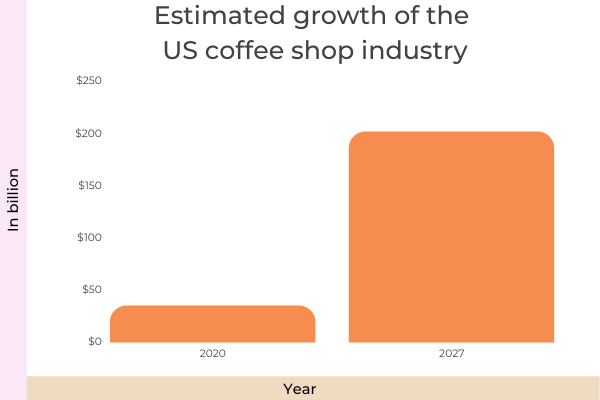

Source: PR Newswire
23. There are 24,000 coffee shops in the United States.
Speaking of the coffee industry in the United States, the country has around 24,000 coffee shops. According to Deals On Health, 50% of the American population over the age of 18 drink espresso, cappuccino, latte, or cold coffee, the annual sales of coffee shops are estimated at $12 billion. It is estimated that the number of coffee shops in the US will increase and more than double up. The US is expected to have more than 50,000 coffee shops in the future.
Source: Deals On Health
24. US imports $4 billion worth of coffee.
Data by E-Importz stated that the United States imports in excess of $4 billion worth of coffee every year. The United States is one of the leading consumers of coffee in the world – Americans consume more than 400 million cups of coffee per day. Due to that, there is a high demand for meeting their coffee needs.
Source: E-Imports
25. US coffee industry presents 1.6% of the total gross domestic product.
According to the data by National Coffee Association, the coffee industry represents 1.6% of the total gross domestic product within the United States. That would mean that the industry’s revenue is more than $225 billion. The United States has one of the largest coffee markets in the world.
Source: National Coffee Association
26. Europe accounts for 30% of the global coffee market.
According to CBI, the Centre for the Promotion of Imports from developing countries, Europe is the largest market of coffee drinkers in the world and it presents about 30% of the global coffee market. CBI stated that the level of coffee consumption per capita is also the highest in Europe at 3.3 kilograms on an annual basis. It is estimated that stable coffee consumption will continue through 2025 and beyond.
Source: CBI
27. Asia and Oceania have a coffee market share of 22%.
Speaking of the market shares in the coffee industry, Europe accounted for 33% of global coffee consumption in 2020/2021. The consumption amount is estimated at 3.244 million tonnes of coffee. Asia and Oceania follow with a market share of 22%. In third place is Latin America with 20% of the market share, while North America has 19%.
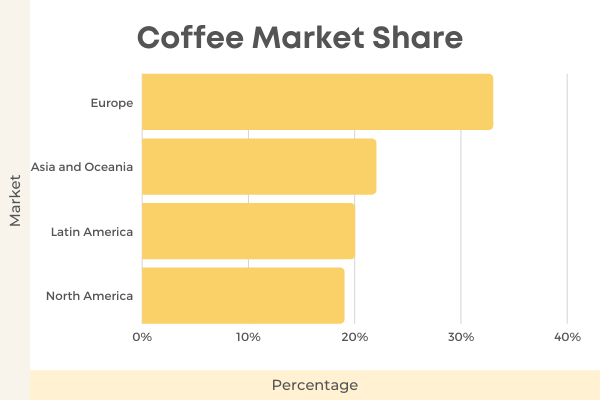

Source: CBI
28. There was a 0,7% increase in coffee demands.
The International Coffee Organization stated that in 2019/2020, world coffee consumption is estimated at 169.34 million bags. That number is 0.7% higher than in the previous time period of 2018/2019. The market demand in 2020 was estimated to exceed production by 470,000 bags of coffee.
Source: International Coffee Organization
29. Millions of bags of coffee are exported every month.
According to the data by Allann Bros. Coffee, the global coffee market sees up to 10 million bags of coffee exported on a monthly basis. In November 2021, world coffee exports amounted to 9.25 million bags compared with 10.56 million in the same period last year.
Source: Allann Bros. Coffee and International Coffee Organization
30. Export of Arabica is almost 80 million bags.
International Coffee Organization stated that in the twelve months ending November 2021, exports of Arabica totaled 79.67 million bags. In the same period the previous year, the number was 80.43 million. Arabica beans account for more than twice as much of the annual coffee export.
Source: Allann Bros. Coffee
31. Specialty coffee accounts for 8% of the total revenue of the US coffee market.
E-Importz reported that specialty coffee sales are having an increase of 20% per year. That accounts for nearly 8% of the total revenue of the US coffee market. Specialty coffee is used to refer to coffee that is graded 80 points or more on a 100 point scale by a certified coffee taster or by a licensed Q Grader. Such coffee is grown at the high altitudes at the specific time of year and in the best soil.
Source: E-Importz and Specialty Coffee Company
32. It is estimated that there will be a significant increase in coffee prices.
Sprudge stated that the price of coffee on the commodities market in 2021 was $1.25. The figures showed that an average price of a coffee per pound has slightly decreased as it was $1.28 in 2020. On the other hand, the coffee statistics provided by Forbes stated that there will be a significant increase in coffee prices in the upcoming years.
Source: Sprudge and Forbes
33. Starbucks sales keep on increasing.
Starbucks coffee shop industry is probably the most popular one in the world. Nasdaq reported that Starbucks expects to have a revenue of $29.1 billion for the year 2021. The company has seen an increase in sales in the last couple of years and there is no doubt that the growth rate will continue to increase in the upcoming years. Speaking of 2021, for the fourth quarter of that year, Starbucks expects to have a growth in global sales between 18% and 21%.


Source: Nasdaq
34. The Swedish coffee market is expected to have a growth of more than 8%.
Sweden is one of the European countries with the highest rates of coffee consumption. According to Statista, the Swedish coffee market is expected to have a CAGR of 8.1% by 2025. Besides Sweden, Spain is expected to see a high growth too. Statista stated that this country expects a CAGR of 7.5%.
Source: Statista
35. Top 5 importers bought almost 50% of the worldwide total coffee amount.
According to World’s Top Exports, the United States, Germany, France, Italy, and Canada are the top 5 importers of coffee. In 2020, these countries bought 47.7% of the worldwide total amount of coffee. If we’re speaking only about Europe, Germany and Italy are top importing countries. Germany imported 1,1 million tonnes of coffee, while Italy 559,000 tonnes.
Source: World’s Top Exports and Eurostat
36. About 89% of European roasted coffee is produced in the EU.
According to Eurostat, Germany and Italy are amongst the top 6 EU coffee production countries. Germany produces 571,000 tonnes of coffee, while Italy 616,000 tonnes. 4 other European countries that produce coffee are Sweden, Spain, the Netherlands, and France. According to Eurostat, Sweden produces 88 000 tonnes of roasted coffee, Spain 128,000 tonnes, Netherlands 134,000 tonnes, and France 149,000 tonnes. These 6 countries produce 89% of the total EU production of roasted coffee.
Source: Eurostat
37. Instant coffee market feel by 9%.
Coffee Rank stated that the soluble coffee market fell by 9%. This means that instant coffee consumption by country is also decreasing. Instant coffee is made from dried coffee extract. Once it is brewed, the water is removed from the extract in order to make powder or dry fragments. We can definitely say that today, the world is divided by preferences of natural and instant coffee.
Source: Coffee Rank
38. Brazil is the coffee production leader.
The top 5 countries declared as world coffee leaders are Brazil, Vietnam, Colombia, Indonesia, and Ethiopia. Brazil is still the production leader, of course. The country has 33% of the coffee market share. Besides Brazil, the mentioned countries are also known as the producers of the best varieties of premium coffees.
Source: Coffee Rank
39. Brazil has almost 30,000 square kilometers of coffee plantations.
Speaking of Brazil, the total area of the country’s coffee plantations is around 27,000 square kilometers so no wonder the country is leading the coffee production. According to Coffee Rank, the most famous Brazilian coffee brands are Fresh Roasted Coffee, Volcanica Coffee, and Ferris Coffee.


Source: Coffee Rank
40. Vietnam produces 2.8 tons of coffee per hectare.
Vietnam is also known for its coffee beans. The country has had significant growth in coffee production in the last couple of years and it is the second-largest producer in the world. Vietnam has the highest yields globally with an output of 2.8 tons of coffee per hectare. Robusta coffee accounts for 97% of Vietnam’s total output.
Source: Coffee Rank and Sucafina Specialty
41. Columbia exports more than 13 million bags of coffee.
According to the data provided by The Coffee Hunters, Colombia has around 875,000 hectares planted with coffee across 590 municipalities and 14 coffee-growing regions. The country exports more than 13 million 60-kilograms bags of coffee every year. Colombia only produces washed Arabica coffee.
Source: The Coffee Hunters and Blue Marlin Coffee
42. Indonesia has a great climate for coffee which is produced by small independent farms.
According to Statista, Indonesia produced 753,900 metric tons of coffee in 2020. The country’s climate is suitable for growing coffee and most of it is produced by small independent farms. Coffee is one of the leading agricultural crop exports of Indonesia. The Indonesian market produces mainly Robusta coffee.
Source: Statista and Coffe Rank
43. Ethiopia is home to Arabica.
Ethiopia produces almost 200,000 metric tons of coffee per year. According to the data by Mordor Intelligence, 95% of the coffee produced in Ethiopia is in the forest areas and is claimed to be organic. This country is home to Arabica coffee. Coffee Rank stated that many coffee farms and brands in Ethiopia are owned by the government.
Source: Coffee Rank
44. Jamaican coffee is widely spread in the world.
The coffee industry in Jamaica has over 7,000 growers and 102,000 farm families who depend on coffee production for survival. The coffee industry in Jamaica generates more than $25 million every year. This country is home to Blue Mountain Coffee. The US coffee market represents 20% of Jamaica’s coffee exports, while Japan imports 80% of its coffee beans from Jamaica.
Source: Jamaica Coffee Exporters Association and Food Truck Empire
45. The coffee industry impacts the global economy.
The coffee industry has a significant global economic impact. The industry is a part of the supply chain that impacts a broad range of businesses, not only coffee shops, but grocery stores, retail stores, family farms, roasters, shipping companies, and in the end – coffee consumers. Due to that, it doesn’t come as a surprise the fact that the industry is growing and increasing every single day – there are 2.25 billion cups of coffee consumed per day. That is the best evidence of the industry’s growth and market demand.
Source: Coffee Rank
46. Up to 74% of independent coffee shops fail in the first 5 years.
Back in 2019, Food Truck Empire reported that according to the Coffee Shop Owners Survey, between 50% and 74% of independent coffee shops fail in the first five years. The most common reasons for failing are the fact that people aren’t prepared for ownership, they don’t have experience, the competition is too big, or they lack working capital. The least reason for failing is bad coffee.


Source: Food Truck Empire
Coffee Industry Employment Statistics
47. Almost 20,000 people work in the US coffee industry.
According to IBISWorld, there are 19,849 people employed in the coffee production industry in the United States. The data stated that the number of employed people is expected to grow by 3.8% per year until 2025. In the typical coffee production business, there are between 4 and 5 people employed.
Source: IBISWorld
48. In 5 years, the number of employed people in the US coffee industry increased by 0.2%.
The number of employed people in the US coffee industry has already seen an increase. The IBISWorld reported that between 2017 and 2022, the number of people employed in the industry increased by 0.2%. No doubt the number will see an even higher increase, as we already mentioned in the previous paragraph.
Source: IBISWorld
49. California has 60,940 baristas.
Speaking of the United States, the Recruiter stated that California is the top state for individuals employed as baristas. The state has 60,940 people employed as baristas and due to that, there will probably be even more job openings since the demands for coffee are already so high. New York follows with 35,000 baristas, while Texas has 31,020 of them. The recruiter stated that Washington has 22,040 people employed as baristas and Florida 21,100.
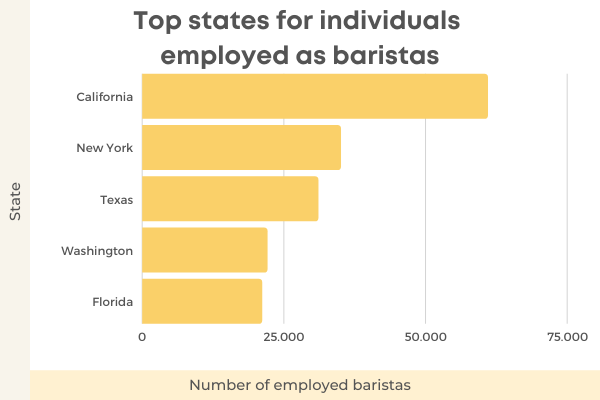

Source: Recruiter
50. The average compensation for a barista in the US is $12 per hour.
To get more specific with working conditions in the US coffee industry, the average compensation for a barista is $12 per hour. When it comes to the shift manager position, the average compensation is about $14 per hour. Baristas are paid rather little for their skills in preparing various types of coffee. However, some companies in the US pay their baristas almost $18 per hour.
Source: Glassdoor and Indeed
51. Montana has the least number of employed baristas.
According to the data provided by Recruiter, the states with the worst prospects for open barista roles are Montana, West Virginia, and Wyoming. The data stated that Montana has only 890 people employed as baristas, West Virginia has 1,210, and Wyoming has 950 baristas.
Source: Recruiter
52. More than 2,000 Starbucks employees have a bachelor’s degree.
Starbucks has 349,000 employees worldwide. According to CompareCamp, over 2,400 Starbucks employees had completed an online bachelor’s degree program at Arizona State University. CompareCamp noted that 12,000 of the employees are currently enrolled in the university.
Source: CompareCamp
53. Starbucks spends more money on healthcare insurance than on coffee beans.
Starbucks is often praised for its employee policy. The CompareCamp data stated that the company rather spends $300 million in healthcare insurance for its partners and employees than on purchasing coffee beans. And that is a good company policy which is taking care of its people.


Source: CompareCamp
54. Brazil has about 3.5 million people involved in the coffee industry.
According to data by Eleven Coffees, as Brazil is the world’s largest coffee-producing country for more than 150 years, it isn’t surprising the country’s coffee industry needs and has many employees. Approximately 3.5 million people are involved in the coffee industry in Brazil, most of them are in rural areas. Brazil has 220,000 coffee farms spread over 10,000 square miles.
Source: Eleven Coffees
Coffee Consumption Statistics
55. Sweden, Japan, and United Kingdom are amongst the top countries with the highest amount of coffee consumption.
E-Importz reported that the top countries in the world with the highest amount of coffee consumption are Finland, Sweden, Switerzland, Germany, France, Italy, Brazil, United States, Japan, and United Kingdom. In Finland, 9 to 10 kilograms of coffee is consumed per person, while in the United Kingdom, consumers most commonly drink 2 cups of coffee per day.
Source: E-Importz and Statista
56. In the US, more than 150 million people drink coffee every day.
According to the data by E-Importz, more than 50% of Americans over 18 years of age drink coffee every day. That high percentage presents over 150 million daily drinkers. On the other hand, 30% of the population drink coffee occasionally. The average coffee consumption in the US is 3.1 cups of coffee per day.
Source: E-Importz and Red Diamond
57. Specialty coffee is a big deal in the United States.
We already mentioned that specialty coffee has seen a massive increase in popularity and sales. According to the report made by E-Importz, 30 million American adults drink specialty coffee beverages on a daily basis. That includes mocha, latte, café mocha, espresso, cappuccino, frozen/iced coffee beverages, and more.


Source: E-Importz
58. The Northeast of the US was the leading region in terms of coffee consumption.
Coffee drinkers can be found all across the United States, however, the total coffee per capita consumption in the US varied by region in 2020. According to Statista, the Northeast was the leading region in terms of coffee consumption. There, roughly 1.97 cups of coffee were consumed per capita per day. In the South, people drank the least amount of coffee at around 1.8 cups a day.
Source: Statista
59. Scandinavian countries drink coffee the most.
Speaking of the consumers in the United States, the annual coffee consumption per capita is 4.2 kilograms. The country is 25th on the list of worldwide annual coffee consumption. According to Roast and Post, Finland, Norway, and Iceland are some of the countries on the top of the list. We already mentioned that in Finland, 12 kilograms of coffee are consumed per capita. In Norway, that number is 9.9 kilograms, while in Iceland, 9 kilograms.
Source: Roast and Post
60. Up to 300 cups of espresso are sold every day.
The average espresso drive-thru business sells between 200-300 cups of espresso and coffee-based drinks every day. According to Business Town, a successful drive-thru coffee chop can easily generate up to $2,000 a day in sales and serve each customer in 60 seconds or less. Drive-thru coffee shops definitely increased in popularity during the COVID-19 pandemic. Besides, people do love their espresso.
Source: E-Importz and Business Town
61. Globally, people consume 500 billion cups of coffee every year.
Worldwide, about 2.25 billion cups of coffee are consumed each day. According to Perfect Brew, that is about 500 billion cups of coffee per year. This doesn’t come as that of a surprise since almost 50% of the world’s population consumes coffee every day.
Source: Perfect Brew and Coffee Rank
62. Almost 50% of Japan’s population love coffee-to-go.
Coffee-to-go is the easiest way to get your dose of caffeine while going to work or being in a hurry. According to the data provided by Perfect Brew, Japan is at the top of the list of coffee-to-go lovers. The data stated that 48% of people in Japan regularly go for a coffee-to-go. In the second place is the United States with 45%, Canada follows with 43%, while in Australia, 23% of people love this type of coffee. Germany, France, Russia, and United Kingdom all have 17% of people who love coffee-to-go.
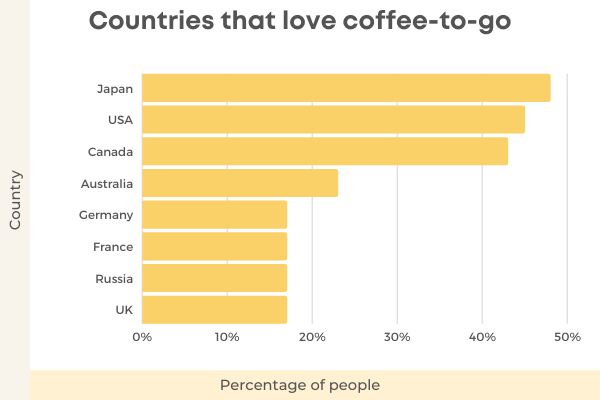

Source: Perfect Brew
63. World prefers instant coffees.
We already mentioned that instant coffee is a rather popular beverage and almost half of the world actually prefers it. But to be more specific, some countries do prefer it more than any other type of coffee. China, Russia, Turkey, and Australia are the leaders when we’re talking about the love for instant coffees. An interesting fact is that some Latin American countries also prefer instant coffee even though they produce the largest volumes of world natural coffee.
Source: Coffee Rank
64. Consumers drink 2.97 cups of specialty coffee per day.
Specialty coffee has its own audience too. According to the data provided by Specialty Coffee Association, drinkers who love this type of coffee consume on average 2.97 cups of it per day. Specialty coffee is a bit different than other types due to its special growth. Some say that this coffee has the most exciting nuances and they refer to it as the tastiest coffee in the world.
Source: Specialty Coffee Association and Specialty Coffee Company
65. About 70% of Millennials love gourmet beverages.
According to the Urban Bean Coffee report, 70% of the coffee consumed by Millennials is in the form of gourmet beverages. Gourmet beverages consist of frozen and iced coffees and espresso-based hot specialty coffee beverages like café mochas, espressos, lattes, and cappuccinos.
Source: Urban Bean Coffee and Science Direct
66. India had a 15% increase in coffee consumption.
Coffee consumption is growing all around the world. But to be more specific, India definitely stands out a bit. According to the data by Mintel, coffee consumption in India is growing rapidly. The market there grew with an annual compounded rate of 15% between 2012 and 2016. In 2020, coffee consumption amounted to over 1,170 thousand 60 kilogram bags.
Source: Mintel and Statista
67. Coffee is a beverage of choice for those people who are financially comfortable.
According to the data by Allann Bros. Coffee, the percentage of people who drink coffee is greater among workers with a higher income. 66% of people who have an income greater than $30,000 consume coffee. On the other hand, 58% of workers who earn less than that amount of income drink coffee.
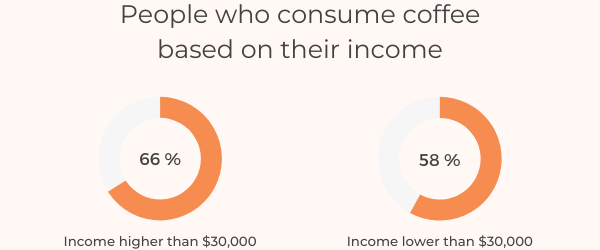

Source: Allann Bros. Coffee
68. Global coffee consumption will grow by 2030.
According to the report by Bloomberg, global coffee consumption is expected to grow by one-third by 2030. That would mean that there will be produced 200 million additional bags of coffee. The main reasons for this growth are wage growth and population increases.
Source: Bloomberg
Coffee Drinkers Demographics Statistics
69. Older people are the biggest coffee consumers.
Deals On Health stated that people aged 60 or older are actually the biggest coffee drinkers. The data shows that 72% of them consume coffee. People aged between 25 and 39 follows, as 64% of them drink coffee. People aged between 18 and 24 drink coffee the least.


Source: Deals On Health
70. Younger people may drink less coffee but they still prefer to consume it several times a day.
Funny thing is that even though adults aged between 18 and 34 drink less coffee than older people (in percentage terms), they still prefer large quantities of coffee and they can drink it multiple times a day. Now, the only difference between consumers is probably the type of preferred coffee.
Source: Coffee Rank
71. Older Americans drink at least one cup of coffee every day.
According to the data provided by Coffee Rank, Americans who are aged 55 or older, often drink at least one cup of coffee per day. To be more specific, 74% of such people love to drink coffee on a regular basis and probably multiple times a day. When we’re talking about older people, they truly do have a habit of drinking coffee and enjoying their time.
Source: Coffee Rank
72. About 78% of students exceed the safe daily dose of consumed coffee.
The Coffee Rank reporter that according to statistics, every day student starts hir/her day with a cup of coffee. They can drink it several times during the day and at night. The data also stated that 78% of students who drink coffee actually exceed the safe daily dose of consumed coffee. That would mean that they drink more than three cups of coffee per day. It isn’t that surprising that students tend to drink that much coffee because it is easier for them to study with a certain dose of caffeine.
Source: Coffee Rank
73. Younger people have a tendency of drinking coffee outside the home.
When we’re talking about locations of drinking coffee, the percentages aren’t that surprising, especially when the focus is on the age groups. According to the data provided by National Coffee Association, coffee drinkers aged 65 or more usually consume coffee at home. Those consumers who are under the age of 35 drink coffee from coffee shops or other locations outside the home. To be more precise, they probably drink coffee from Starbucks.
Source: National Coffee Association
74. Millenials consume almost 50% of all coffee in the United States.
Millennials in the United States have embraced the coffee culture. According to a Bloomberg report, Millennials consume 44% of all coffee in the United States. This generation loves specialty coffee and drinks it more than any other age group. Also, Millennials are more likely to drink coffee outside the home and are willing to spend more on quality coffee. What is interesting is that Millennials are attracted to coffee beverages that are complex and innovative.
Source: Bloomberg
75. About 65% of Hispanic Americans are more likely to consume coffee every day.
Speaking of demographics of coffee consumers in the United States, according to the National Coffee Association survey, Hispanic Americans (65%) are more likely to consume coffee on a daily basis compared to other races. The survey stated that 64% of Caucasians drink coffee every day, 60% of Asians drink coffee, and 54% of those who identify themselves as African Americans consume coffee on a daily basis.
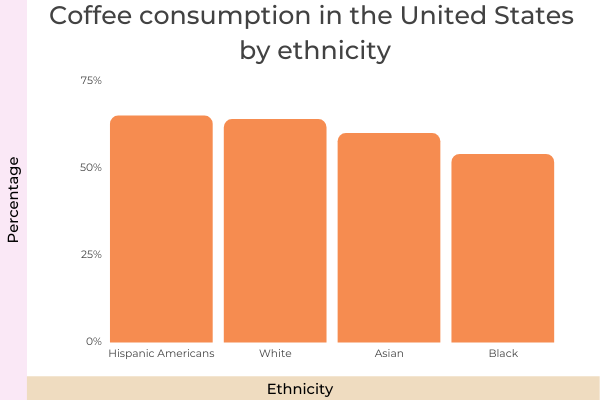

Source: National Coffee Association
76. Seniors drink three times more cups of coffee a day than younger adults.
We already mentioned that more than 70% of seniors love to drink coffee, but did you know that they drink three times as many cups a day than younger people? Statista stated that nearly half of people aged between 18 and 24 drink coffee, however, that is not enough to beat the percentage of the seniors. The older you are, the more likely you’ll drink big amounts of coffee.
Source: Statista
77. Almost 70% of women drink coffee every day.
In previous paragraphs, we mentioned that Americans drink 400 million cups of coffee every day which equals 146 billion cups of coffee per year. According to the data provided by Disturb-Me-Not, from those mentioned cups of coffee, 66% of women drink coffee every day compared to 62% of men that do so. Not a big difference at all. It probably varies from time to time.
Source: Disturb-Me-Not
78. Men spend almost $10 more on coffee than women.
According to data by Visual, men spend $21.32 on coffee per month, while women almost $10 less. Women spend around $13.78 per month. Data stated that men consume coffee in order to get the job done, while women drink coffee just to relax. And they do it a lot cheaper than men.
Source: Visual
79. Seniors drink 2.18 cups of coffee.
We mentioned a couple of times now that seniors drink the most coffee, but let’s talk numbers. According to Statista, in 2020, people aged 70 and over drank about 2.18 cups of coffee per capita in the United States. The coffee consumption for people aged between 25 and 29 stood at roughly 2.15 cups of coffee per day.
Source: Statista
Coffee Shop Statistics
80. In the United States, independent coffee shops have a revenue of $12 billion.
According to the data provided by E-Importz, independent coffee shops equal $12 billion in annual sales. At the moment, there are 24,000 coffee shops in the United States, and we already mentioned that statistics show there will be approximately 50,000+ coffee shops within the years to follow. Coffee shops are rather important in the United States, especially because of the high number of Millennials who love to drink coffee from coffee shops.
Source: E-Importz
81. Local coffee shops have big competition with the top national coffee brands.
The data by Brandon Gaille states that 70% of sales in the US coffee industry are generated from the top 50 coffee shop operators. The problem with small local coffee shops is that they must compete with the top national brands such as Starbucks, Seattle’s Best, and Peet’s Coffee. Outside the United States, these chains have big growth opportunities too. Starbucks for example owns 5,500 international coffee shop locations.


Source: Brandon Gaille
82. Small coffee shops sell about 230 cups of coffee per day.
Despite the fact that small coffee shops have to fight for the customers’ attention due to big coffeehouse chains, their average number of sold cups of coffee per day is about 230 pieces. Small coffee shops sell other beverages too, perhaps even some snacks and sweets. If we include those other purchases in the total sales number, the overall profit margin is quite impressive. Small coffee shops can always count on their loyal customers and those who don’t want to complicate their coffee orders.
Source: Coffee Rank
83. Coffee shop has up to 500 visitors per day.
The average number of coffee shop visitors ranges between 150 and 500 people. The number of visitors depends on 3 factors – the size of the coffeehouse, available offer, and popularity, according to Coffee Rank. However, many people will choose smaller and cozy places rather than popular coffeehouses. Also, many of the visitors love simplicity when ordering a coffee. Good offer and varieties of coffee, but simplicity.
Source: Coffee Rank
84. The coffee shop industry is worth more than $40 billion.
Data by Brandon Gaille estimates that in 2021, the coffee shop industry reached a revenue of $46.2 billion. While we’re waiting for the official 2021 report, we can most definitely say that 2022, as well as the upcoming years, will bring massive growth in sales and popularity not only in the coffee shop market but the entire coffee industry.
Source: Brandon Gaille
Starbucks Coffee Statistics
85. The United States and China have the highest number of Starbucks stores.
Starbucks is the most famous, popular, and largest coffee shop in the world. The company has approximately 32,660 stores in the world. According to Finances Online and the available statistics, the United States and China have the highest numbers of stores. The United States has more than 15,000 Starbucks, while China has 4,704.
Source: Finances Online and Statista
86. Starbucks had a high increase in sales in 2021.
The data by Statista stated that in 2021, Starbucks generated a revenue of $29.1 billion. That number presents a high increase since the previous year when the company made a revenue of $19.61 billion. The results for 2020 were highly impacted by the COVID-19 pandemic but there is no doubt that Starbucks is back on its track when it comes to business and sales.
Source: Statista
87. In 2019, Starbucks made $16.65 billion in the United States alone.
If we take another look back, in 2019, Starbucks generated a total of $26.52 billion in revenue. The majority of this figure was made by the Americans. That year, Starbucks generated $16.65 billion of revenue in the United States, while international locations generated $6.19 billion. These figures show us the already mentioned significant increase in sales in 2021 which was in the short term interrupted in 2020. Despite the COVID-19 pandemic, the sales are going amazing.
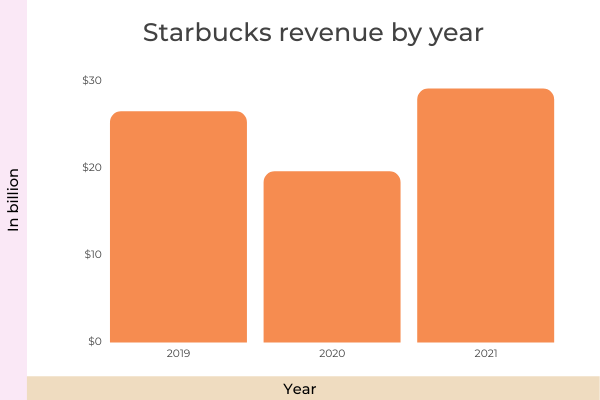

Source: Statista
88. Starbucks has a steady revenue growth.
According to the data provided by Macrotrends, Starbucks had steady revenue growth from 2005. Then, the company had revenue of $6.3 million, and in just three years later, that number went up to $10.38 million. Starbucks had a steady growth rate since that with 2020 as an exception when the revenue decreased by 11.28%.
Source: Macrotrends
89. Japan has 1,464 Starbucks stores.
We already mentioned that the United States and China have the highest numbers of Starbucks in the world. In third place is Japan. There are 1,546 Starbucks locations. Canada follows with more than 1,400 Starbucks stores, while the United Kingdom has 1,089 stores.
Source: Statista
90. In 2017, Starbucks spent $282.6 million on ads.
Marketing and ads are big factors in the coffee industry. According to the data provided by Statista, Starbucks spent $258.8 million on ads in 2020. The highest amount of money spent on ads was in 2017. That year, the company spent $282.6 million on ads. In 2011, Starbucks had the lowest advertising costs in a 10-year-period of $141.4 million.
Source: Statista
91. Starbucks had a massive increase in mobile app orders back in 2020.
Despite the fact that in 2020, Starbucks lost billions of dollars, the company’s mobile app orders made a record of 24% of all transactions in 2020. Starbucks mobile app statistics for 2020 show that the fourth fiscal quarter was actually a record-breaker for mobile app orders. But the increase wasn’t only in the last quarter of the year. Since the beginning of 2020, Starbucks witnessed an increase in mobile orders – in the first quarter by 17%, in the second quarter by 18%, and in the third quarter by 22%. This increase is mostly caused by the COVID-19 pandemic and all the safety precautions.
Source: The Verge
92. Beverages account for 60% of the total Starbucks revenue.
The data by Business Quant states that 60% of Starbucks revenue in 2019 came from beverages. Pastries and confections made up 18% of the total amount, while 8% came from the sales of packaged coffee and tea. The data also stated that the remaining 14% of the revenue came from licensing, ingredients, and others.
Source: Business Quant
93. You can try almost 90,000 drink combinations in Starbucks.
According to Blue Water Credit, Starbucks offers more than 87,000 drink combinations. The statistics showed that if you drink about 238 cups per year, which is 19 new drink combinations per month, you’ll be able to try all combinations. Well, someday. The most popular Starbucks drinks are Green Tea Latte, Hazelnut Latte, Pumpkin Spice Latte, and Mint Cherry Mocha Hot Cocoa.


Source: Blue Water Credit
94. More than 30% of Starbucks customers are aged between 19 and 29.
Before the COVID-19 pandemic, about 37.8 million Americans visited Starbucks every day. Now, that number is a bit lower, but it’s getting there. According to FinancesOnline, 33.78% of Starbucks customers are people aged between 19 and 29. 30.4% of customers are people aged between 30 and 49 while 21.5% of customers are older people aged between 50 and 64.
Source: FinancesOnline
95. Starbucks uses 4 billion cups every year.
In the last Starbucks annual report, the stores were likely to use between 2.916 and 2.946 billion cups or an average of 8,070,428 per day. Starbucks website states that on a global basis, the stores use approximately 4 billion cups every year. Now imagine how high the amount beverages account for the annual Starbucks revenue.
Source: Leo Qin
96. Starbucks’ desirable customers are those with higher incomes.
What is interesting is that, according to data by CHRON, Starbucks’ target market is often described as affluent or high income (about $90,000). The data also states that every affluent neighborhood has a Starbucks not far away. But despite that, there are many Starbuck cafes that are surrounded by middle-income neighborhoods where people don’t have that high income.
Source: CHRON
97. Students spent up to $97 on coffee every month.
According to Coffee Rank, students love getting a Starbucks coffee. The data states that they mostly go for a large coffee of up to 600 ml almost every day. It is estimated that every student spends somewhere between $21 and $93 on coffee every month. This is actually quite understandable since coffee is a dose of energy. Thanks to that, it is easier for them to study.


Source: Coffee Rank
American Coffee Consumption Statistics
98. Every year, Americans drink 146 billion cups of coffee.
Some of these following numbers are already mentioned, however, due to their importance, we’re going to highlight them once again. The data provided by Disturb-Me-Not states that 64% of American adults consume coffee every day. In total, they drink about 400 million cups of coffee every day. On a yearly basis, they drink about 146 billion cups of coffee.
Source: Disturb-Me-Not
99. One pound of green bean coffee is around $1.
With more than 20,000 large coffee shops in the United States, the number of such establishments continues to grow every single month, according to Coffee Rank. The available data and statistics stated that the price of coffee has dropped to around $1 per pound of green beans so it became a lot easier to get a hold of. Of course, coffee processing, roasting, and grinding come with their own expenses, but with such a significantly low price of coffee, the total expenses of opening and owning a coffee shop are quite lower than they were.
Source: Coffee Rank
100. Specialty coffee is the largest coffee submarket in the US coffee industry.
We already mentioned that specialty coffee is a big deal in the United States. The sales of such coffee have a 20% increase per year and thanks to that, it accounts for almost 8% of the total revenue of the US coffee market. According to Statista, there are over 31,000 specialty coffee shops operating in the United States. Specialty coffee is now the largest coffee submarket in the US coffee industry.
Source: E-Importz, Statista, and JavaPress
101. Oregon has the cheapest coffee.
The data by Real Good Coffee Company states that New York is the number one state for drinking coffee. People there don’t only consume more coffee than any other state, but they also pay the most for a cup of cappuccino. Washington is in second place of coffee consumption, while California and Oregon follow. Oregon has the cheapest coffee that costs about $3.38, while Ohio has the highest prices for coffee with a cost of $8.16 per pack.
Source: Coffee Rank
102. Almost 80% of Americans prepare coffee at home.
The data by Disturb-Me-Not stated that 79% of Americans actually prepare coffee at home. That statistic came as a bit of a surprise since a lot of Americans do love to go to coffee shops. The same data stated that 45% of US coffee consumers brew their coffee by a drip coffee maker. Using that machine definitely gives a coffee shop touch and flavors.
Source: Disturb-Me-Not
103. San Francisco has the most coffee shops per capita.
There are a couple of cities in the United States which stand out due to their high numbers of coffee shops per capita. According to E-Importz, San Francisco is in the lead, followed by Seattle, Portland, Oakland, Pittsburgh, Paradise, Salt Lake City, New Orleans, Minneapolis, and Tacoma. The leading San Francisco has 1,062 coffee shops, while the second runner, Seattle, has 737 coffee shops. Tacoma is ranked 10th and it has 144 coffee shops.
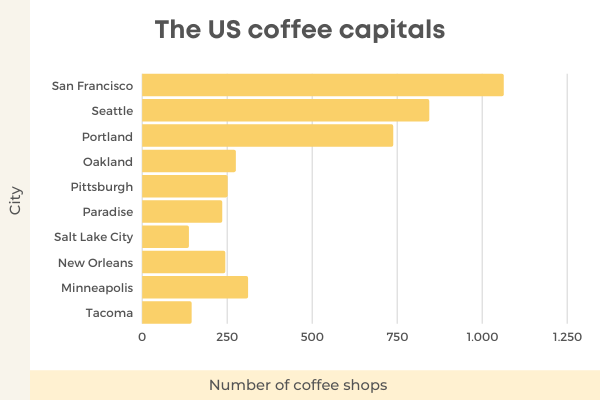

Source: Redfin
104. Water is the most consumed beverage in the US, coffee is second.
The data provided by Deals On Health stated that coffee is the second most frequently consumed beverage in the US. That actually doesn’t come as a surprise because 64% of American adults consume coffee every single day. The data showed that bottled water is the most consumed type of beverage and coffee comes as a second runner.
Source: Deals On Health
105. Almost 50% of Americans drink coffee at breakfast.
One of the modern American traditions is consuming coffee at breakfast. 44% of American adults drink coffee with or right after eating breakfast. According to CreditDonkey, morning coffee has become a ritual because of its stimulatory effects. Coffee eases up the morning and lack of sleep, and boosts the body with additional much-needed energy.
Source: CreditDonkey
106. More than 70% of older Americans drink coffee every day.
Perfect Brew reported that the oldest part of the US society consumes coffee the most. 72% of Americans who are aged 60 or older, drink coffee on a daily basis. Americans aged between 18 and 24 drink it the least – about 47% of them. The 3 most common reasons why Americans drink coffee are because of its taste, better digestion, and because everyone else does it.
Source: Perfect Brew
107. The US coffee production industry had a 0.2% increase in the number of employees.
According to data by IBISWorld and Statista, coffee production in the United States is the 140th ranked manufacturing industry by employment and the 588th largest in the US. As of 2022, the coffee production industry in the US has 19,849 employees. The number of people employed in the industry increased by 0.2% over the last 5 years.
Source: IBISWorld and Statista
108. Women spend $300 more on coffee than men.
Perfect Brew data stated that an average coffee drinking American woman spends about $2,327 yearly on coffee compared to an average coffee drinking American man who will spend about $1,934 on coffee on a yearly basis. However, men consume 2.22 cups of coffee, while women only 1.79 cups.
Source: Perfect Brew
109. Only 5% of Americans consume instant coffee.
There are various types of coffee and all of them have their own fans. According to the National Coffee Association, 44% of Americans drink traditional coffee. 40% of people love gourmet traditional coffee. 24% of Americans consume espresso-based beverages, 11% non-espresso-based beverages, while 5% of people love to drink instant coffee.
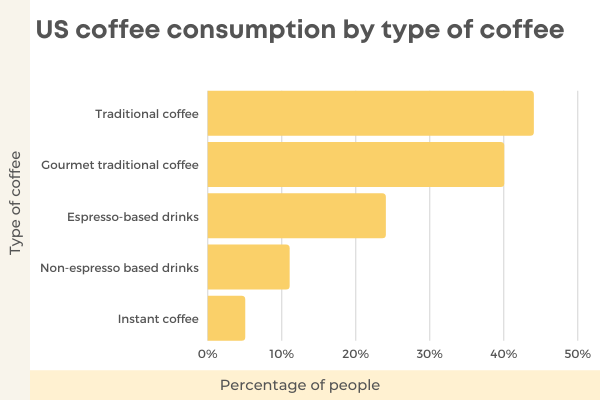

Source: National Coffee Association
110. About 14% of Americans drink 4 to 5 home-prepared cups of coffee.
We already mentioned that Americans love preparing their coffee at home. According to the National Coffee Association, 29% of Americans who prepare coffee at home drink 2 cups per day. 25% of them drink 1 cup per day, while 13% consume 3 cups of coffee per day. The survey also stated that 14% of Americans drink 4 to 5 homemade cups of coffee and 9% of them have 6 and more cups.
Source: National Coffee Association
111. About 23% of Americans drink coffee on the go.
Besides drinking coffee at home, 24% of Americans consume it at work, while 23% of them drink coffee to go. According to a survey conducted by Statista, restaurants, and hotels account for 15% of consumed coffee, and school, college, and university account for 4%.
Source: Statista
112. Almost 80% of coffee shops in the US are part of the 3 leading coffee chains.
When it comes to the market shares of the leading coffee shops in the United States, based on the number of stores, Starbucks is in the first place. Dunkin follows with 9,570 stores, while JAB-owned brands are in third place with 4,739 stores. The JAB owns Caribou Coffee, Espresso House, Peet’s Coffee, and more. What’s interesting is the fact that 78% of coffee shops in the US are part of the Starbucks, Dunkin’ Donuts, or Caribou Coffee chains.
Source: Perfect Brew
113. Only 4% of Americans add alternative dairy products to their coffee.
According to the National Coffee Association, 40% of Americans add milk or sweeteners to their coffee, while only 4% of them add alternative dairy products. What is interesting is that the number of people adding only milk to their coffee has grown by 66% since 2015.
Source: National Coffee Association
114. Cappucino and latte are favorite espresso-based drinks to 33% of Americans.
Espresso-based drinks are quite popular for the last couple of years and their consumption continues to grow. The National Coffee Association stated that cappuccino and latte are the most consumed espresso-based drinks, both have 33% of consumers. 28% of Americans consume cold brew, 26% espresso, and 23% mocha. Macchiato and americano are consumed by 18% of Americans, while flat white by 8% of them.
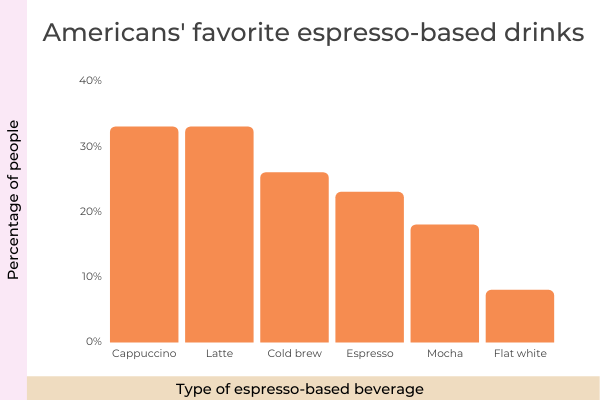

Source: National Coffee Association
115. Almost 50% of Americans don’t care if coffee is environmentally friendly.
A report by the National Coffee Association stated that 53% of US coffee lovers prefer to buy coffee that is environmentally friendly. On the other hand, 47% of Americans who drink coffee do not pay attention to these matters and details. However, it is very admirable to see that more than half of the Americans who drink coffee actually do care about this problem.
Source: National Coffee Association
116. Millennials consume gourmet beverages, espresso-based beverages, and non-espresso-based beverages.
We already mentioned that Millennials love to drink coffee. Now, National Coffee Association made a research on Millennials’ coffee preferences. 70% of them consume gourmet beverages. 32% of Millennials consume espresso-based beverages every day, while 14% of them drink a non-espresso-based beverage on a daily basis. It is interesting to see that there is no particular number of Millennials who love to consume traditional black coffee. However, we mentioned they do like innovative coffee beverages.
Source: National Coffee Association
Coffee Health Statistics
117. Espresso is low in calories and great for those who want to lose weight.
Espresso is a rather healthy drink. One of the well-known coffee nutrition facts is that espresso has a very low number of calories, about 5.4 kcal per cup. With that in mind, it is completely safe to drink if a person wants to lose weight. Besides, espresso contains antioxidants that boost the immune system.
Source: Deals On Health and Aditya Birla Capital
118. Iced latte has more calories and fats.
According to the data provided by Nutrition Value, 248 grams of flavored, iced latte contains 89 mg of caffeine. It isn’t as caffeinated as brewed coffee, however, lattes and similar beverages have more fats and calories. Iced coffee can easily make a person overweight in case of too many consumed flavored and sugary coffee.


Source: Nutrition Value
119. Adults can consume up to 400 mg of caffeine per day.
The data by Heart Foundation states that coffee and heart rate problems are strongly connected. And coffee increases the heart rate. Due to that, there are certain limits for coffee intake, especially for kids. They can safely consume no more than 3 mg kg of their body weight a day. Pregnant or breastfeeding women must also limit caffeine up to 200 mg a day. For other adults, 400 mg of caffeine per day is the healthy and safe limit.
Source: Heart Foundation
120. Coffee may reduce the risk of Alzheimer’s disease.
Web MD reported that the risk of Alzheimer’s disease may be 16% lower for coffee drinkers. This disease affects 1 in 8 people aged 65 or older. Scientists believe that coffee can reduce the risk, however, there aren’t enough studies to completely confirm this theory. But what doctors do know is that black coffee reduces the risk of type 2 diabetes.
Source: Web MD
121. Coffee consumers have a 24% lower risk of getting type 2 diabetes.
Speaking of type 2 diabetes, each daily cup of coffee may lower your risk of this condition by 7%. According to Healthline, people who drank 3 to 4 cups of coffee per day had a 24% lower risk. Since type 2 diabetes is one of the biggest health problems in the world which currently affects more than 300 million people, these are rather important findings.
Source: Healthline
122. Coffee is beneficial for the liver.
According to the data provided by Healthline, coffee is highly beneficial for the liver. Many studies showed that coffee drinkers have up to 80% lower risk of cirrhosis. Besides that, coffee appears to lower the risk of liver cancer. The study found out that people who drank 2 to 4 cups of coffee per day had a 43% lower risk of this cancer. Those people who drank 5 or more cups of coffee, had a 76% reduced risk.
Source: Healthline
123. Coffee drinkers have a lower risk of depression.
Healthline reported that people who drank 4 or more cups of coffee per day, were 55% less likely to die by suicide. The reported studies showed that people who drink coffee have a lower risk of depression and more than 50% lower risk of suicide. These are interesting and important studies and findings.
Source: Healthline
124. Everyone’s body needs a different amount of caffeine.
According to Healthline, consuming between 4 to 5 cups of coffee is good from an overall health perspective. However, every person is different and unique, and of course, reacts differently to this beverage. The best solution is just to listen to the body and see what works best for every person.
Source: Healthline
125. Caffeine improves memory and decreases fatigue.
The reason why so many students turn to coffee is that it helps them with studying. According to MDPI and WebMD, coffee consumption has been positively associated with a higher education level. Caffeine improves memory and mental functioning, and it can improve short-term memory, speed up reaction time, and decrease fatigue. All these factors ease up the studying process.
Source: MDPI and WebMD
126. Coffee is loaded with antioxidants.
Coffee is very rich in antioxidants such as polyphenols and hydrocinnamic acids that may improve health, as well as reduce the risk of several diseases. However, coffee may be the biggest dietary source of antioxidants, but it doesn’t provide the same antioxidants as whole plant food like vegetables and fruits.


Source: Healthline
127. Older people who drink coffee multiple times a day have a 10% lower risk of death.
According to the data by the National Institutes of Health, older adults who drink coffee, caffeinated or decaffeinated, may actually have a lower risk of death. The data stated that men and women aged between 50 and 71, who drank 3 or more cups of coffee per day, had approximately a 10% lower risk of death.
Source: National Institutes of Health
128. Drinking 3 cups of coffee per day may reduce the risk of death by 13%.
Speaking of risks of death, National Coffee Association reported that drinking one cup of coffee per day, with or without caffeine, is associated with a 3% reduced risk of death while drinking 3 cups of coffee may reduce the risk of death by 13%. Besides, drinking coffee is associated with a reduced risk for death from various causes.
Source: National Coffee Association
129. Drinking 2 cups of coffee per day may increase the lifespan by up to 2 years.
Healthline reported that drinking any type of coffee (decaf, instant, ground) on a regular basis may increase the person’s lifespan. The same data stated that drinking coffee can lower the risk of premature death by 20% to 30%. Drinking two cups of coffee per day can increase life by up to 2 years.
Source: Healthline and Independent
130. Coffee is healthy, but it may come with side effects if it is consumed too much.
Of course, drinking too much coffee can also have some side effects such as anxiety, insomnia, digestive issues, muscle breakdown, and caffeine addiction. In case of these side effects, people should cut back on the amount of consumed coffee and consult a health care provider.
Source: Healthline
Coffee Waste Statistics
131. Every year, 6 million tonnes of coffee waste is sent to landfills.
Every day across the globe more than 1 billion cups of coffee are consumed. Most of the coffee grounds which are used to make those cups are thrown away. According to the data by World Economic Forum, 6 million tonnes of those waste is sent to landfills every year. In these times, the coffee industry should definitely need to take that into the account and focus on creating environmentally friendly coffee cups.
Source: World Economic Forum
132. About 25% of coffee waste is reused.
According to Perfect Daily Grind, some countries do repurpose their coffee waste, however, 75% of the waste ends up in landfills. Only the reaming 25% of it is reused to make agricultural products such as fertilizer. This is a small percentage but it is definitely positive to see it. Small steps lead to big impacts.
Source: Perfect Daily Grind
133. Coffee grounds release methane.
Such waste is really bad for the environment. As the World Economic Forum states, decomposing coffee grounds release methane into the atmosphere, the second-most abundant greenhouse gas. Methane has 28 times higher greenhouse effect than carbon dioxide and is one of the primary causes of global warming.
Source: World Economic Forum and UCL
134. Every year, the world has 18 million tonnes of wasted coffee grounds.
According to the data by bio-bean, on an average basis, 11 grams of fresh ground coffee go into each cup. That is around 9 million tonnes of ground coffee brewed every year. This results in about 18 million tonnes of wet, wasted coffee grounds. This waste is then typically sent to landfills.


Source: bio-bean
135. Australia has 65,000 tonnes of coffee waste every year.
Australia creates a lot of waste too. According to Perfect Daily Grind, Australia creates about 65,000 tonnes of coffee waste every single year. This waste only includes the coffee grounds left behind from brewed coffee, but it doesn’t take into account other forms of coffee waste. Like in many countries, Australian coffee waste mostly goes to landfills too.
Source: Perfect Daily Grind
136. Nearly 50% of coffee product launches in 2020 had an environmental or ethical claim.
In order to reduce coffee waste, in 2020, 48% of all new coffee product launches around the world carried an ethical or environmental claim. That is almost twice the number from a decade ago when only 25% of coffee launches were sustainable. No doubt this number increase by a few percentages in 2021.
Source: Food Navigator
To Wrap It Up
Coffee is the second most-consumed beverage in the world and its industry is worth more than $156 billion. While some drink it because of the taste and the energy, the popularity of the coffee made people drink it – because everyone does it. Even though the coffee industry has a great impact on the world, it also has a negative impact on the environment. With millions of coffee waste every year, the landfills are filled with coffee grounds. Decomposing coffee grounds release methane into the atmosphere, the second-most abundant greenhouse gas which is one of the primary causes of global warming. However, sustainability has become one of the industry’s key factors so we can hope to see some improvements regarding coffee waste. In the meanwhile, there is no doubt that coffee will get even more global fans.




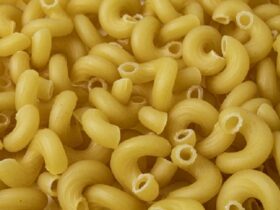



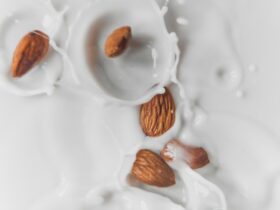
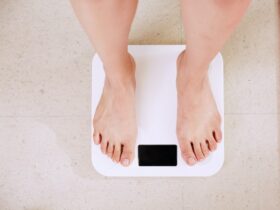


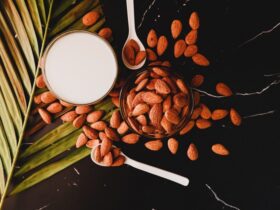




Leave a Reply